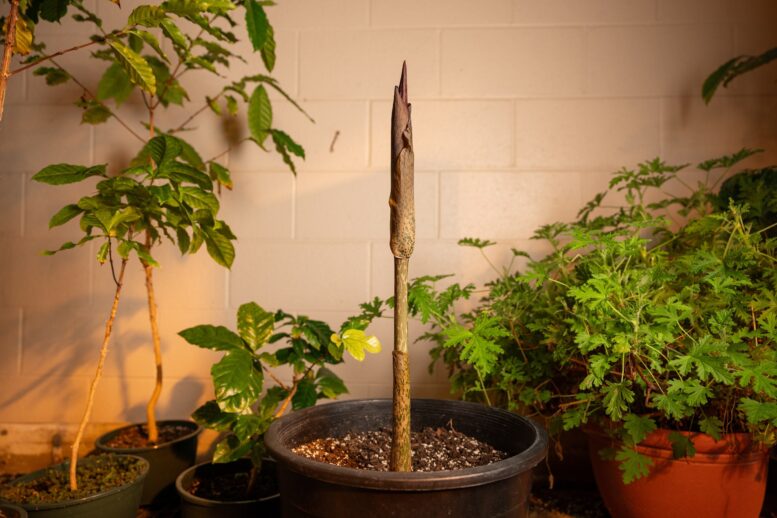From BGSU OFFICE OF MARKETING & BRAND STRATEGY
Of the hundreds of plants growing in the Bowling Green State University greenhouse, perhaps none cause more of a stink than the Konjac [Pronounced kaan·jak].
Native to eastern Asia, the small, unassuming plant quickly creates an undeniable stench likened to a dead animal when it blooms a single purple flower each year, aiming to attract flies and other potential pollinators.
With blooms typically taking place in late winter and early spring, the Konjac flowered over the weekend. The bloom and smell are only set to stick around for a couple of days before the Konjac before it begins the transformation into a more common-looking leafy plant.
“I am excited to experience my first bloom with this plant since joining BGSU,” Greenhouse Manager Evili Martins said. “I have not had the opportunity to work with a Konjac before, so I’ve been studying up and working with my colleagues to learn all that I can about it. It’s essentially a one-of-a-kind opportunity to have a plant like this in our region.”
While Martins is relatively new to BGSU, the Konjac is not. The University acquired the peculiar plant roughly a decade ago from a greenhouse in southern Ohio. Since then, BGSU Greenhouse workers have maintained the foul-smelling plant from bulb to full-blown flower each year.
Often compared to the Titan arum, or corpse flower, Martins said the Konjac is unique in its own right, boasting a spotted stem pattern, intricate leaves, a relatively fast growth rate – up to an inch per day in some cases – and, of course, its putrid smell.
Outside of its pungent scent, the Konjac serves some practicality in everyday life. Its starchy tubers, or corms, are edible when dried or cooked and can be made into flour, jelly or supplements that can benefit one’s digestion, heart and weight loss, according to Cleveland Clinic.
“From its fast growth to its unusual smell, the Konjac is definitely a unique plant,” Martins said. “Not many greenhouses, let alone colleges or universities, have a plant like this, so BGSU is really in a class of its own. It certainly creates a great learning opportunity for our staff and students.”
While the Konjac offers a distinctive sensory experience, it is just one of the many plants in the BGSU Greenhouse that provide students with real-world learning opportunities.
Outside of participating in research, students from all majors can get involved in the building’s four greenhouses – including special tropical and desert collections – where they can assist with plant upkeep and propagation, with direct access to experts like Martins who can answer questions and offer valuable firsthand insight.
“The BGSU Greenhouse is a great place for students to learn and gain hands-on experience in biology and other sciences,” Martins said. “Being located at a university, our greenhouse allows students the unique opportunity to connect one-on-one with researchers and experts who can answer their questions or offer tips and tricks for plant care. It’s basically an extension of the classroom or lab.”
Members of the learning and greater community are welcome to visit the BGSU Greenhouse near Park and Leroy avenues to see, and smell, the plant for themselves from 8 a.m. to 5 p.m. Monday-Friday and can schedule a formal tour by calling 419-372-2375.

